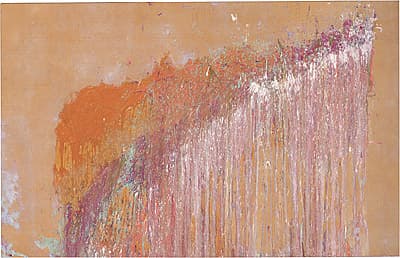
Larry
POONS
Japan
1937
United States from 1940
Mover
1972
synthetic polymer paint on canvas
on canvas
inscribed on stretcher, verso, c.c., black felt-tipped pen, "Mover 1972 L. Poons"
canvas
173.0 (h)
x 271.0 (w)
cm
Frame
176.0 (h)
x 274.0 (w)
x 4.0 (d)
cm
Gift of Jon Plapp and Richard McMillan 2005
National Gallery of Australia, Canberra
NGA 2005.364
© Larry Poons. Licensed by VISCOPY, Australia
- the artist;
- with David Mirvish Gallery, Toronto, 1972;
- by whom bought by Jon Plapp and Richard McMillan, Sydney;
- given to the National Gallery of Australia, August 2005
- Abstract Expressionism: the National Gallery of Australia celebrates the centenaries of Jackson Pollock and Morris Louis
- 14 Jul 2012 – 24 Feb 2013
- Bronwyn Campbell, ‘Larry Poons: Mover’ artonview 44, summer 2005, p. 34
Mover is painted on unprimed canvas: a flat wash background is soaked with a brilliant diagonal spray of orange to form the basis for the central motif. The sense of spontaneity is derived from the artist’s original splash of paint, yet the apparent impulsive freedom of execution in the finished work is in fact the result of painstaking layering and overpainting. In the juxtaposition between impulsiveness and attention to detail, Mover hovers on the cusp of Poons’ transition from the studied illusion of his Op works to the abandonment of deliberation that later he pursued.
Poons’ Op paintings of the 1960s are characterised by a flat wash of monochromatic acrylic, overlaid with dots or ellipses in oil paint. The contrast between the two paint types creates a sense of movement: the differences in texture and richness gives the illusion of the dots floating over the surface of the canvas. Still in his 20s, Poons was heralded as one of the great new artists of the New York scene. Then, suddenly, he renounced his signature style. Feeling his work was too timid, he attempted to form a freer relationship with the paint itself. In 1969 he began to pour paint onto canvases on the floor. These works were known as his ‘elephant skin’ paintings, due to the thick pooling of the medium, which as it dried would wrinkle and crack. On discovering that he could achieve the effect of layering and banding by tacking his canvases to the wall and throwing paint at them, Poons allowed paint and gravity to work together to create a cascade motif, as seen in Mover. He began to make and exhibit his ‘drip’ paintings in 1972. These exhibitions comprised two main groups—works like Mover, with an isolated cascade motif, and those he made on a whole roll of canvas that was then cut into pieces.
At first glance, Mover has little in common with Poons’ earlier work. His apparent rejection of the Op aesthetic in fact represents a very clear link between the Op paintings and his later career practice. The tension between spontaneity and care links the painting to the Op works: the impression that the central motif hovers above the canvas. This is emphasised by the different textures and colour intensities of the paint—just as the oil spots seemed to hover the acrylic background in the Op works, so the brightness of the cascade separates from the surface of the canvas by the contrast with the flatness of the background. As a result, Mover conveys a greater impression of movement than in other, more developed, works in this style.[1] Bridging the gap between his Op painting and his Lyrical Abstraction, Mover represents a key phase in Poons’ oeuvre.
Bronwyn Campbell
[1] Elsewhere the spread of paint across the whole canvas ties the dissected compositions down; there is little to latch onto, and the eye slides over the surface of the work, just as the paint slid down the canvas when it was first applied.
The Gallery also holds an untitled screenprint by the artist, from the Wadsworth Atheneum portfolio Ten prints by ten painters 1964
